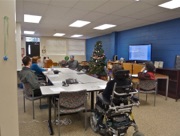This is the first page of the preface.
What is this document all about?
This web-document provides guidelines and additional information that public agencies and other non-profit entities should follow to share information about the use of their trail systems and recreational facilities, and information that should be considered during the design of new trails and features.
These Guidelines do not propose to define the terms “ADA accessible” or “inaccessible” as they apply to trails, but to share information about trails and amenities so that potential trail users can make their own informed decisions.
Who is Access Recreation?
Access Recreation is a Portland, Oregon based, non-profit committee that has been working for several years to develop these uniform informational guidelines.
When put in place, these guidelines will provide the public with easy access to better information on the accessibility of parks and recreation trails in the states of Oregon and Washington and beyond. This information will increase opportunities and safety by allowing trail users to make a more-informed decision as to which trails may best suit their needs and ability levels without being limited solely to designated ADA accessible trails.
Who are its committee members?
The Access Recreation Committee is comprised of representatives from federal, state and local park agencies and other organizations involved in public recreation and accessibility. A list of Access Recreation Committee members and their websites is available by clicking here.
How is this document organized?
Before this Executive Summary, there is a Table of Contents which provides links to all the sections that follow. They are divided into Primary topics that are essential and common to all trail descriptions; Secondary topics that may be useful over time as budgets allow; a prototypical webpage; a series of special topics, such as Interacting with Persons with Disabilities; excerpts from the ADA Standards for Accessible Design 2010 and Guidelines for Outdoor Developed Areas; an extensive Glossary of terms; and a list of additional Resources.
Summary 1
This is the first page of the preface.




Next page
Previous page






